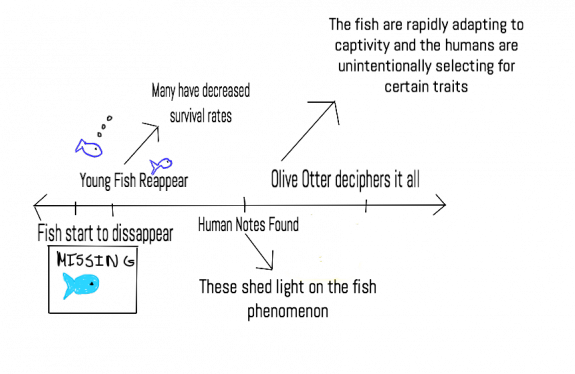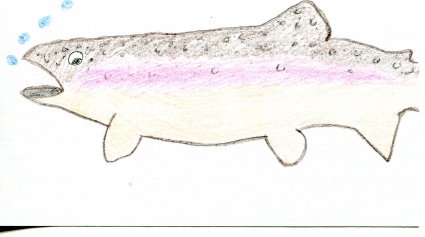 Introducing A08: Will He Survive?
Introducing A08: Will He Survive?
A Fishy Affair
Posted
|
Views: 1,012
A Fishy affair
Olive Otter
As any otter will tell you, steelhead trout are first and foremost dinner. They are not the sort of creatures you invite to an evening party at your river home but instead serve to your guests. Yet, since the humans started poking around Hood River, even an otter like me started to wonder about the state of the steelhead fish. New steelheads, still so young they wouldn't make a tasty snack, would suddenly appear in the river while older fish would disappear never to return again. Many of the new young fish don't last very long, and are an easy target for even the most unskilled, portly, otter. Around the time such occurences would happen, witnesses described seeing humans clothed in white lab coats muttering frantically about accelerated adaptation to captivity and accidentally selecting for certain traits. A rather knowledgable frog has since informed me that accelerated adaptation is when a population is adapting to an environment very quickly, sometimes in only a few generations. This amphibian informer also reminded me that certain traits are favorable to survival, and such helpful traits tend to get passed on, or selected for. This selection of traits can take place in the wild or even in a mad scientist's laboratory.
Then, one of these strange humans, who called himself Mark R. Christie, left behind some crumpled papers, found by a rather nosy sea gull I won't name. This discovery made things a little clearer for us river creatures. The papers, which humans sometimes call an article, were titled "Genetic Adaptation to Captivity Can Occur in a Single Generation" and revealed a lot about this troublesome matter. In brief, the humans have been taking steelhead fish from Hood River and breeding them in captivity before releasing their offspring, before they are fully grown, back into the wild.
The scientists found that fish who had high reproductive success, or the most offspring, in a secret evil lab called a hatchery tended to produce offspring with decreased chances of survival back in the river. A fact, any otter would have been happy to tell them. The scientists realized that because steelheads are what we call around here a little fecund, and are always producing a large amount of offspring very quickly, they were rapidly adapting to captivity, even within a generation. By breeding the steelheads in the hatchery, scientists were unintentionally selecting for certain traits that would lead to the fish doing well in the hatchery but not in the Hood River.
The fish thriving in captivity, who are the most likely to be breeding often and successfully, have the potential to pass on characteristics helpful in the hatchery to their offspring. Though these traits may be useful when in a hatchery they may be fatal in the Hood River. The scientists have a few ideas about what traits are accidentally being selected for in the hatcheries but they believe a major trait unintentionally being selected for is growth rate. Hatcheries release fish at a year, but us responsible wildlife never allow our steelheads to smolt, or migrate from the river to the sea as a young adult, until they are at least two years old. Thus, the fish being released from hatcheries, though closer to sexual maturity at a younger age than wild trout, are smaller, which is not a favorable trait for a tumultuous ocean journey.
Fish who live and breed within a hatchery are also raised without proper manners-- they never know to avoid predators in the same way one of their wild counterparts would. This lack of proper behavior, though not needed in captivity, is a disadvantage in the wild.
Though the scientists were not intentionally selecting on their steelhead population's growth rate, fecundity, or behaviors they unintentionally did so based on when they released fish back into the wild. They also bred fish in an environment where not having certain characteristics doesn't lead to a decreased chance of survival, meaning these traits can be passed on to offspring. It seems like sometimes humans, especially those who aren't called scientists, don't think of adaptation as something that can happen in captivity. Yet, hatcheries are environments as well, and certain traits will still aid in survival. If I spoke Human, I would tell them they should try to keep this fact in mind, especially when trying to build up suffering populations out here in the wild with programs in captivity. Of course, less fecund populations will not adapt as quickly to their domestic environment because there is a greater time period between generations. Thus, scientists should look at the rate at which a population produces offspring and how long it takes their young to reach maturity before starting a breeding program. They also never have the animals in these programs sign waivers, which is purely bad legal practice.
Just remember, the next time you are going for a swim, that there may be a human's net waiting to snatch you up and test the concepts of evolution and natural selection on you. Swim safe!


A Timeline of Events.

Sources:
Christie, Mark R., et al. “Genetic adaptation to captivity can occur in a single generation.”
Proceedings of the National Academy of Sciences of the United States of America 109.1
(2012): 238-242. Web. 15 March 2016.
 Magazine Posts
Magazine Posts Table of Contents
Table of Contents